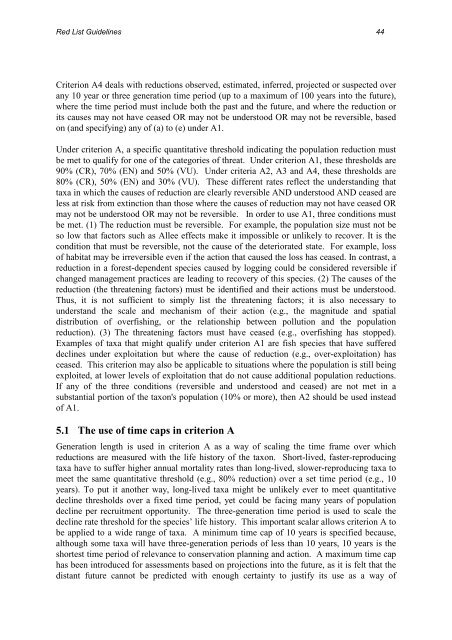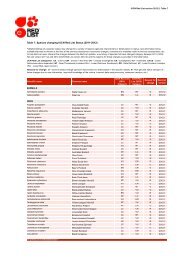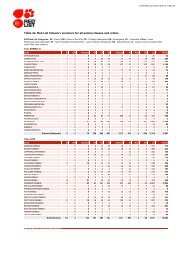IUCN Red List Guidelines - The IUCN Red List of Threatened Species
IUCN Red List Guidelines - The IUCN Red List of Threatened Species
IUCN Red List Guidelines - The IUCN Red List of Threatened Species
Create successful ePaper yourself
Turn your PDF publications into a flip-book with our unique Google optimized e-Paper software.
<strong>Red</strong> <strong>List</strong> <strong>Guidelines</strong> 44<br />
Criterion A4 deals with reductions observed, estimated, inferred, projected or suspected over<br />
any 10 year or three generation time period (up to a maximum <strong>of</strong> 100 years into the future),<br />
where the time period must include both the past and the future, and where the reduction or<br />
its causes may not have ceased OR may not be understood OR may not be reversible, based<br />
on (and specifying) any <strong>of</strong> (a) to (e) under A1.<br />
Under criterion A, a specific quantitative threshold indicating the population reduction must<br />
be met to qualify for one <strong>of</strong> the categories <strong>of</strong> threat. Under criterion A1, these thresholds are<br />
90% (CR), 70% (EN) and 50% (VU). Under criteria A2, A3 and A4, these thresholds are<br />
80% (CR), 50% (EN) and 30% (VU). <strong>The</strong>se different rates reflect the understanding that<br />
taxa in which the causes <strong>of</strong> reduction are clearly reversible AND understood AND ceased are<br />
less at risk from extinction than those where the causes <strong>of</strong> reduction may not have ceased OR<br />
may not be understood OR may not be reversible. In order to use A1, three conditions must<br />
be met. (1) <strong>The</strong> reduction must be reversible. For example, the population size must not be<br />
so low that factors such as Allee effects make it impossible or unlikely to recover. It is the<br />
condition that must be reversible, not the cause <strong>of</strong> the deteriorated state. For example, loss<br />
<strong>of</strong> habitat may be irreversible even if the action that caused the loss has ceased. In contrast, a<br />
reduction in a forest-dependent species caused by logging could be considered reversible if<br />
changed management practices are leading to recovery <strong>of</strong> this species. (2) <strong>The</strong> causes <strong>of</strong> the<br />
reduction (the threatening factors) must be identified and their actions must be understood.<br />
Thus, it is not sufficient to simply list the threatening factors; it is also necessary to<br />
understand the scale and mechanism <strong>of</strong> their action (e.g., the magnitude and spatial<br />
distribution <strong>of</strong> overfishing, or the relationship between pollution and the population<br />
reduction). (3) <strong>The</strong> threatening factors must have ceased (e.g., overfishing has stopped).<br />
Examples <strong>of</strong> taxa that might qualify under criterion A1 are fish species that have suffered<br />
declines under exploitation but where the cause <strong>of</strong> reduction (e.g., over-exploitation) has<br />
ceased. This criterion may also be applicable to situations where the population is still being<br />
exploited, at lower levels <strong>of</strong> exploitation that do not cause additional population reductions.<br />
If any <strong>of</strong> the three conditions (reversible and understood and ceased) are not met in a<br />
substantial portion <strong>of</strong> the taxon's population (10% or more), then A2 should be used instead<br />
<strong>of</strong> A1.<br />
5.1 <strong>The</strong> use <strong>of</strong> time caps in criterion A<br />
Generation length is used in criterion A as a way <strong>of</strong> scaling the time frame over which<br />
reductions are measured with the life history <strong>of</strong> the taxon. Short-lived, faster-reproducing<br />
taxa have to suffer higher annual mortality rates than long-lived, slower-reproducing taxa to<br />
meet the same quantitative threshold (e.g., 80% reduction) over a set time period (e.g., 10<br />
years). To put it another way, long-lived taxa might be unlikely ever to meet quantitative<br />
decline thresholds over a fixed time period, yet could be facing many years <strong>of</strong> population<br />
decline per recruitment opportunity. <strong>The</strong> three-generation time period is used to scale the<br />
decline rate threshold for the species’ life history. This important scalar allows criterion A to<br />
be applied to a wide range <strong>of</strong> taxa. A minimum time cap <strong>of</strong> 10 years is specified because,<br />
although some taxa will have three-generation periods <strong>of</strong> less than 10 years, 10 years is the<br />
shortest time period <strong>of</strong> relevance to conservation planning and action. A maximum time cap<br />
has been introduced for assessments based on projections into the future, as it is felt that the<br />
distant future cannot be predicted with enough certainty to justify its use as a way <strong>of</strong>






